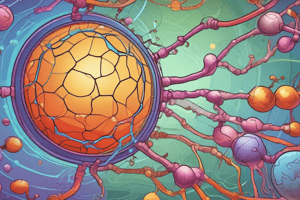Podcast
Questions and Answers
What is the main function of enzymes in biochemical reactions?
What is the main function of enzymes in biochemical reactions?
- Facilitate molecular rearrangements (correct)
- Reduce substrate flexibility
- Inhibit reactions
- Slow down reaction rates
Why do enzymes change shape when they bind with substrate molecules?
Why do enzymes change shape when they bind with substrate molecules?
- To increase reaction rates (correct)
- To inhibit the reaction
- To decrease reaction rates
- To prevent substrate binding
What do cells form when multiple steps are required for molecular transformations?
What do cells form when multiple steps are required for molecular transformations?
- Metabolic pathways (correct)
- Protein catalysts
- Catalytic converters
- Metabolic inhibitors
How do cells balance their catabolic and anabolic pathways?
How do cells balance their catabolic and anabolic pathways?
In what situation would cells synthesize glucose from other materials?
In what situation would cells synthesize glucose from other materials?
What is the role of cell metabolism in research fields such as diabetes and obesity?
What is the role of cell metabolism in research fields such as diabetes and obesity?
What are the three main purposes of cell metabolism?
What are the three main purposes of cell metabolism?
Which enzyme-catalyzed reactions allow organisms to grow and reproduce?
Which enzyme-catalyzed reactions allow organisms to grow and reproduce?
What characterizes the basal metabolic state of a cell?
What characterizes the basal metabolic state of a cell?
What is a distinguishing feature of glycolysis?
What is a distinguishing feature of glycolysis?
Which process has a higher ATP yield per glucose molecule?
Which process has a higher ATP yield per glucose molecule?
What are the fundamental energy demands characterizing cell metabolism?
What are the fundamental energy demands characterizing cell metabolism?
Flashcards are hidden until you start studying
Study Notes
Cell metabolism is the set of life-sustaining chemical transformations within the cells of living organisms. The three main purposes of metabolism are the conversion of food/fuel to energy to run cellular processes, the conversion of food/fuel to building blocks for proteins, lipids, nucleic acids, and some carbohydrates, and the elimination of nitrogenous wastes. These enzyme-catalyzed reactions allow organisms to grow and reproduce, maintain their structures, and respond to their environments.
Cell metabolism is characterized by three fundamental energy demands: to sustain cell maintenance, to trigger aerobic fermentation, and to achieve maximum metabolic rate. The basal metabolic state of a cell is characterized by a maintenance energy demand, which is currently assumed to represent the energy cost incurred to maintain ions balance between the cell and its environment. This demand is often estimated from the extrapolation of the growth dependence of the energy demand to the basal state. However, it is not a constant independent of the cell growth rate.
Cells utilize glycolysis and oxidative phosphorylation to satisfy these energetic demands. Glycolysis has a low yield of 2 mol ATP/mol glucose but is characterized by a high horsepower (energy produced per volume of enzymes). Oxidative phosphorylation has a higher yield of 32 mol ATP/mol glucose but is characterized by a lower horsepower.
Enzymes are protein catalysts that speed up biochemical reactions by facilitating the molecular rearrangements that support cellular processes. They are flexible proteins that change shape when they bind with substrate molecules, which increases reaction rates. Many of the molecular transformations that occur within cells require multiple steps to accomplish, forming a coordinated series of chemical reactions known as metabolic pathways.
Cells must balance their catabolic and anabolic pathways to control their levels of critical metabolites and ensure that sufficient energy is available. For example, if supplies of glucose start to wane, cells will synthesize glucose from other materials or start sending fatty acids into the citric acid cycle to generate ATP. Conversely, in times of plenty, excess glucose is converted into storage forms, such as glycogen, starches, and fats.
Cell metabolism plays a crucial role in many research fields, including diabetes, obesity, pancreatic beta cell function, adipose tissue biology, lipid metabolism, cardiovascular biology, immunometabolism, bone homeostasis, aging and stress responses, sarcopenia, intermediary metabolism and cancer, neuronal control of metabolism and metabolic derangements causing neurodegeneration, circadian biology, stem cell energetics, exercise metabolism, the biology of mitochondria and other metabolic organelles, and peroxisomes and the ER.
Studying That Suits You
Use AI to generate personalized quizzes and flashcards to suit your learning preferences.




